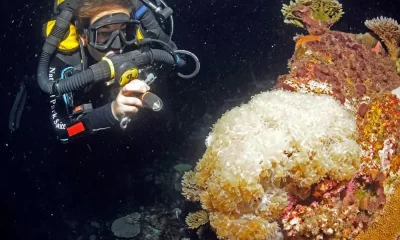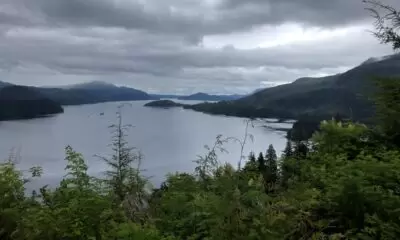Cave
Dem Bones, Dem Bones, Dem Wookey Bones
British Cave Diving Group (CDG) training officer Michael Thomas reports on his find at Wookey Hole—he and his team including his son Robert uncovered a mass of human bones (800 BCE-400 ACE) following the October 2020 flood. It wasn’t his first time.
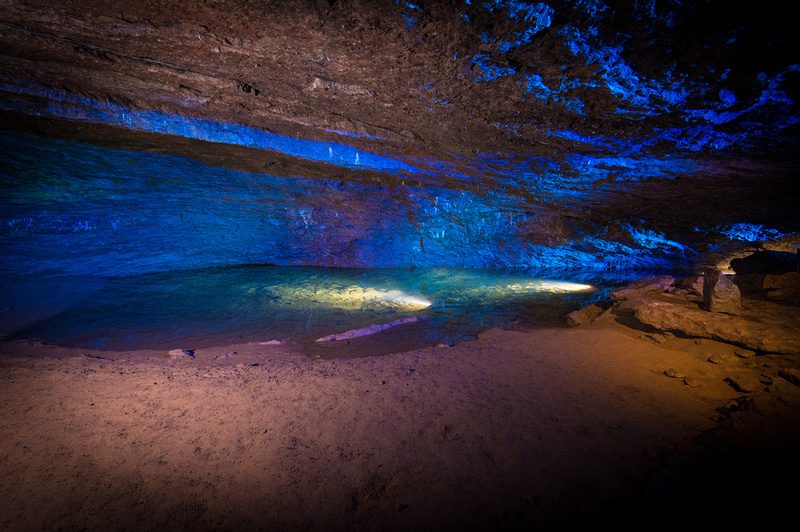
by Michael Thomas
Header photo of Chamber Three in Wookey Hole by Jason Brown, BARDO Creative
Predive click: “Dem Bones Dem Bones Dem Dry Bones,” by Delta Rhythm Boys
Romano-British archaeological human remains have recently been discovered in Wookey Hole Cave. The remains could be dated to anywhere between the Iron Age (800 BCE) and the Roman Empire (400 ACE). Wookey Hole Cave is situated on the southern flank of the limestone Mendip Hills in Somerset, UK, close to the city of Wells. The cave formation is typical for the region; British cave formation usually consists of streams entering dry caves at the top of a hill—such as Swildonʼs Hole—which reappear in the larger Resurgence cave and join River axe, a tributary of the Bristol Channel.
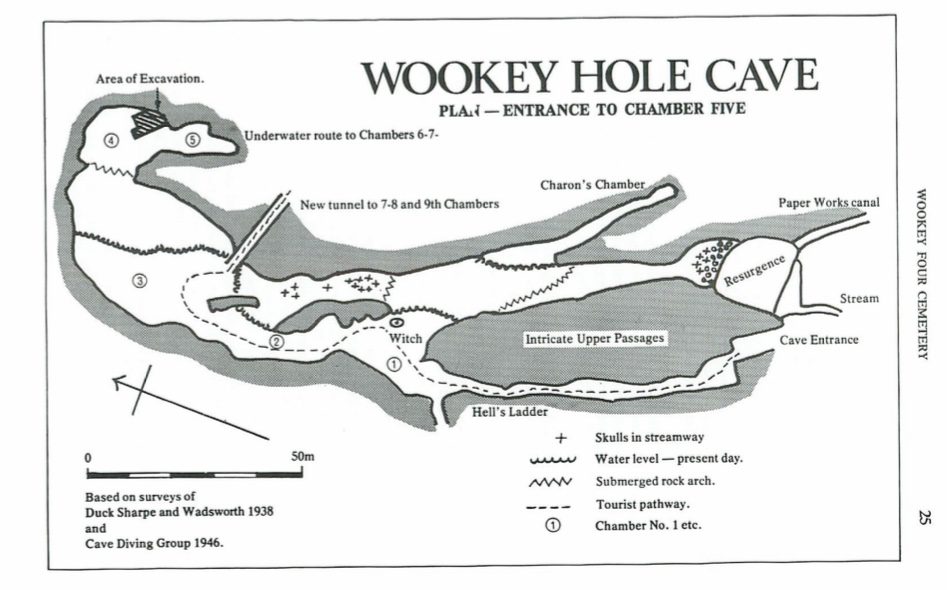
Humans have interacted with Wookey Hole Cave for centuries. According to early 1900s archaeological excavations, humans occupied the cave from the Iron Age into the Roman occupation period. While cave divers made their first tentative penetrations into the subterranean kingdom of Wookey Hole in 1935 using standard dress diving equipment, they had no idea that the cave was a treasure trove in disguise. A 1946 training dive unearthed three human skulls, several skeletal bones, and a nearly intact Romano-British Pot.
Since these first artifacts were discovered just upstream of chamber one and the dry cave formation known as the Witch of Wookey, explorers realized that the rest of the system was probably hiding some gems. For the following decade, further diving operations tackled chamber three and into the Resurgence Cave, uncovering even more remains and artifacts. By 1956, explorers had documented eighteen human skulls, a variety of other bones, pottery, and Roman coins.
The divers’ discoveries during this period resulted in great speculation that the human remains found had been sacrificed to the Witch of Wookey! Archaeologists pointed out that if logic prevailed, many skulls were found upstream of the Witch, and were unlikely to have rolled upstream against the flow of the underground River Axe.
Some bones were located in the sediment silt banks of dry chamber four, prompting archaeologists to propose that the chamber may have been used as a burial site. To further explore this hypothesis, the University of Bristol Speleological Society conducted extensive archaeological work in chamber four between 1973 and 1974 and found significant evidence to support this theory.
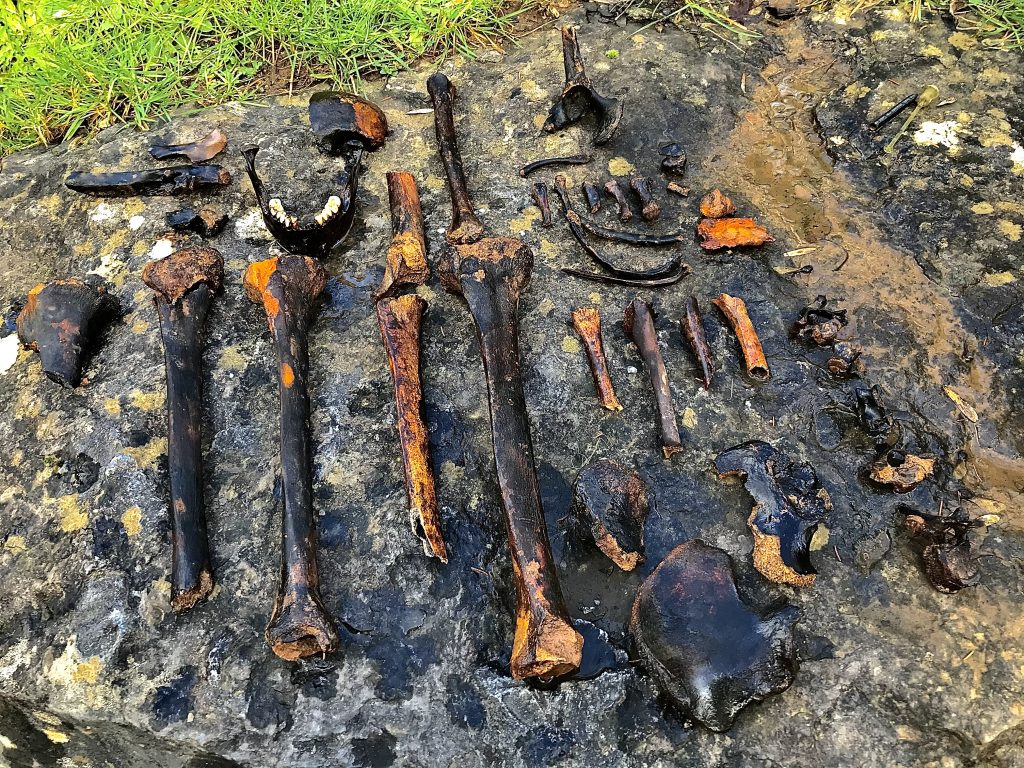
The fourth chamber was—in the mid-1700s—the furthest cave area that humans had discovered. This was the case until the middle of the 18th century, when workers from a nearby paper mill built a dam across the mouth of the cave in order to provide a head of water to drive the mill’s machinery. The dam raised water levels by around 1.75 m/5.7 ft and sealed off chamber four, except when the sluice gate was opened, draining the dam, or when it was entered by divers.
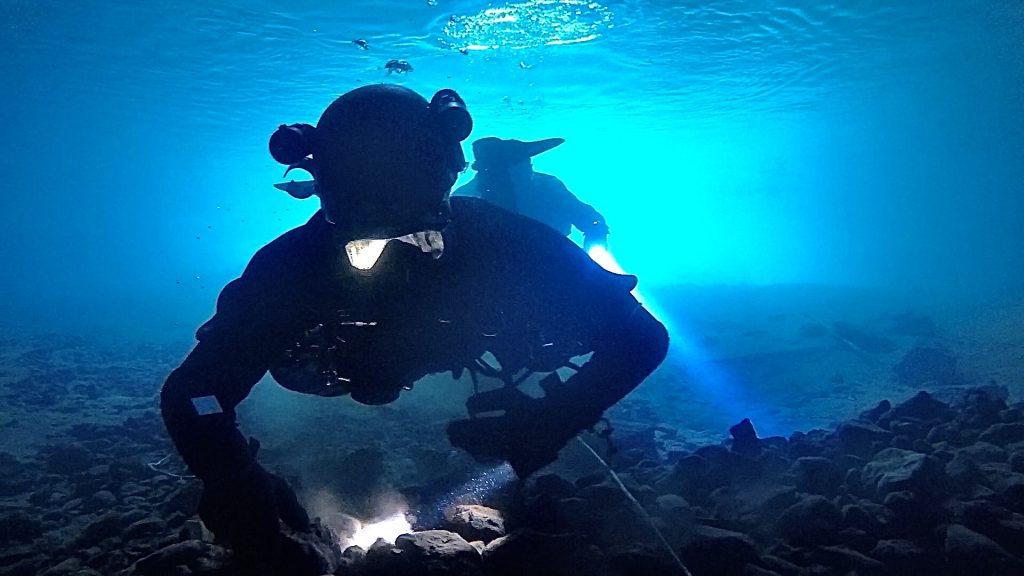
Modern Day Discoveries
In 1993, when I was a trainee cave diver, Wookey Hole revealed another one of its secrets. While exiting the cave via the Resurgence (spring) after a training dive, my instructor, Robin Brown, spotted the top of a human skull exposed from the silt banks on the cave floor. The skull was recovered at the request of the Wookey Hole cave management team, preserved, and placed in the park’s Cave Museum, where it remains to this day. I was fascinated with the find and the history.
I learned that, after heavy flooding in the cave, the sediment and silt banks shift before slowly moving back into their normal positions over time once the typical flow is restored. Significant flood events are infrequent, so divers don’t usually have a high probability of finding artifacts and remains. In 2019, while on a training dive with my son, Robert Thomas, we were pleased to find an intact Roman pot just downstream of chamber three. At the park’s request, we removed the pot, and it was eventually dated to the third or fourth century ACE.
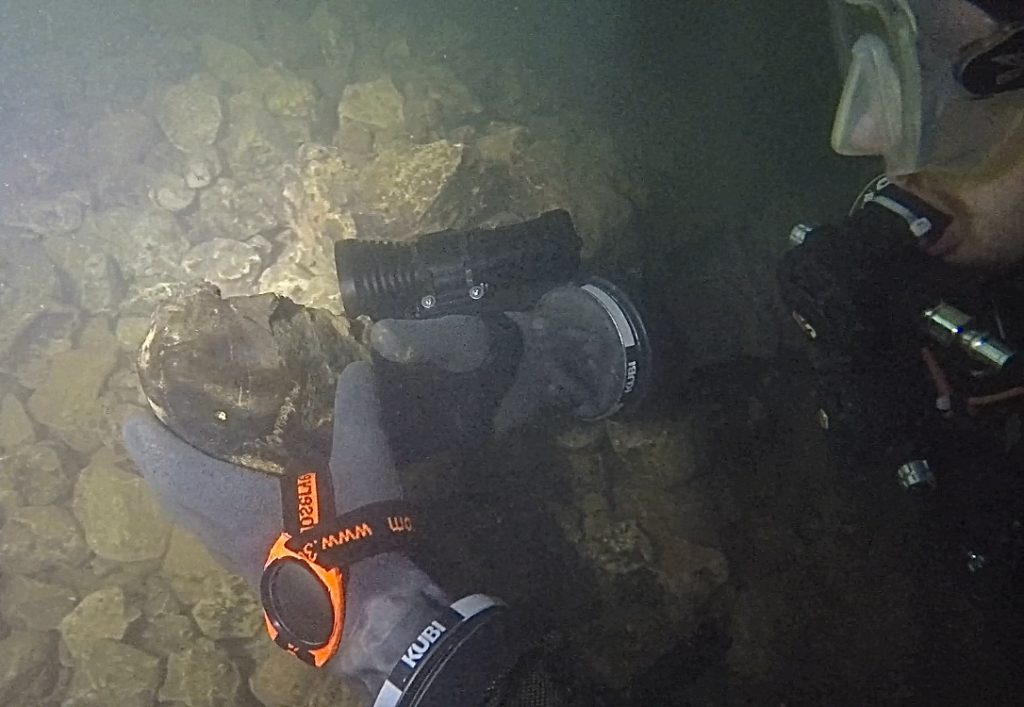
This find also resides in the museum. Since 2019, as a result of our find, we have kept an eye open for items of archaeological interest while diving this section of cave. We didn’t find anything of significance until the middle of the Covid pandemic, when on October 4, 2020, a major flood event impacted Wookey Hole cave and the surrounding area. Increase in water levels was record-breaking, at 1.4 m/4.6 ft above average, washing away parts of the river banks both inside and outside the cave.
Once conditions had calmed down, Chris Binding, Caving Advisor to Wookey Hole Caves as well as Wild Wookey—the award winning caving program filmed at the park—took a walk underground to survey the damage. Upon reaching chamber three, Chris found a human bone on the river bank. Realising that the underwater section of the cave may have changed significantly, Chris asked Robert and me to dive and inspect for any human remains that may have been uncovered.
After the flood, it took several weeks for the cave to be diveable and in a visible condition but, as winter took hold and cold weather brought drier, colder conditions (and a higher number of Covid cases!), we began diving on behalf of Wookey Hole Cave. The first dive was a confusing mess of buried line and damaged line belays, debris washed into the underwater sections of the cave, and—as we suspected—massive changes in the sediment and silt banks. Upon closer inspection, we started to see many bones under a fine layer of silt or sticking out from the sediment banks. We duly reported our findings and, with agreement from the park, we planned on collecting as many bones as we could, in order to save them from damage—and possible loss—as the silt banks settled back into place over time.
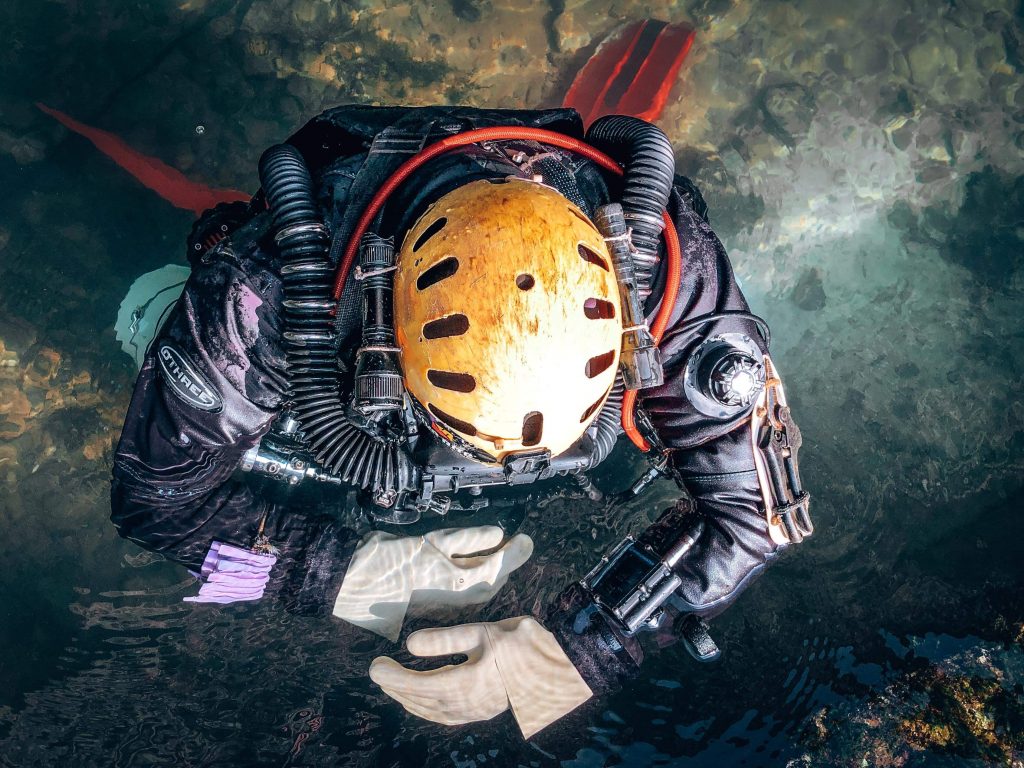
Over the years, all of these remains have washed out of the original burial ground in chamber four, and have become completely displaced from their original orientation. On our next dive we had some help from Charlie Read Henry, who diligently removed as much debris and washed-in rubbish from the work area underwater as possible. As a result of his work, we had higher visibility at the site, we could perform line and line belay repair, and we were able to devise a system for collecting and transporting bones out of the cave.
Over the next three dives—which were all around ninety minutes to two hours long, with Robert and me on CCR, joined by Craig Eley on open circuit—we retrieved a significant quantity of human bones. Some were just lying in the silt, while others required very careful excavation to dislodge them from the sediment banks. Upon surfacing, we surrendered the bones (stored in cave water while awaiting archaeological inspection) to Chris. Throughout these dives, we collected every bone that was visible to us, but the normal winter storms and higher water flow temporarily stopped the project.
Once conditions improved again, our aim was to re-check all of the areas where we had previously recovered bones, just to make sure we’d done a thorough job. The first area heading upstream was just inside the Resurgence at the bottom of the 3 m/10 ft deep entrance slope. Robert headed upstream to check out chamber three. Hanging motionless in the passage looking down at the area, I had just about decided nothing was there when a small, oval mark in the sediment among the rocks caught my attention. Waving the silt and some sediment away, I realised what I was looking at: the eye sockets on a human skull.
After 45 minutes of very carefully moving the sediment and rocks away from the skull, it was released from the bank. Robert had rejoined me by this point, and he very carefully lifted the skull and swam it out of the cave for delivery. It’s surprising just how heavy an intact human skull actually is. I also find working with skulls to be a thoughtful time—handling one of the most significant parts of another human being. I had to wonder who they were, what their life was like, and even how they died. Working with human skulls is humbling and invokes the utmost respect.
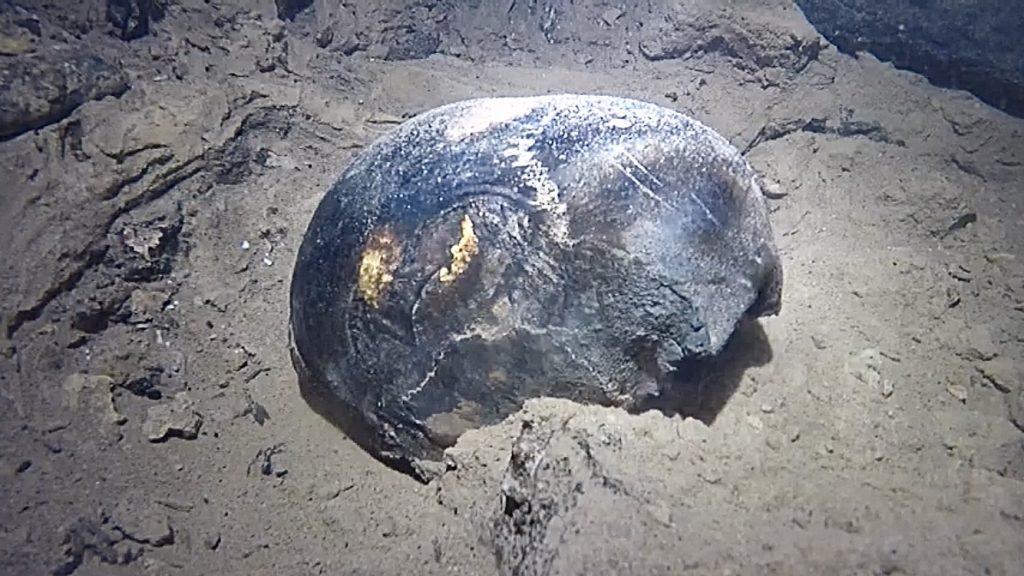
Chris and I decided to do “Just one more dive.” This time, diving solo, I checked over the Kiss Sidewinder CCR and ran through a pre-dive checklist with my surface support (Thanks Chris!). I set off into the cave again, passing and perusing all of the work sites, finding nothing. Until, on the way out and just upstream from the Witch of Wookey, I noticed a narrow undercut in the passage between large boulders around 2 m/6.6 ft from the dive line. While I wasn’t interested in finding more passages, I thought it was possible that washed-up skeletal bones could have collected there. Wriggling in between the boulders and the wall, I didn’t find much until I looked at a section of wall made up of rocks and sediment at the back of the undercut.
There I saw a smooth, dome-shaped object amongst the debris. It looked like the top of another intact skull. But, I could only squeeze in far enough to touch it with the fingers on my left hand. I started moving some larger boulders out of the way in order to get in a bit further and work one handed. After nearly an hour of working in zero visibility with one hand, the skull was free and on its way out of the cave. When I surfaced, Chris asked, “How was the dive? Did you find anything?” Slowly, and with great care, I handed over the skull.
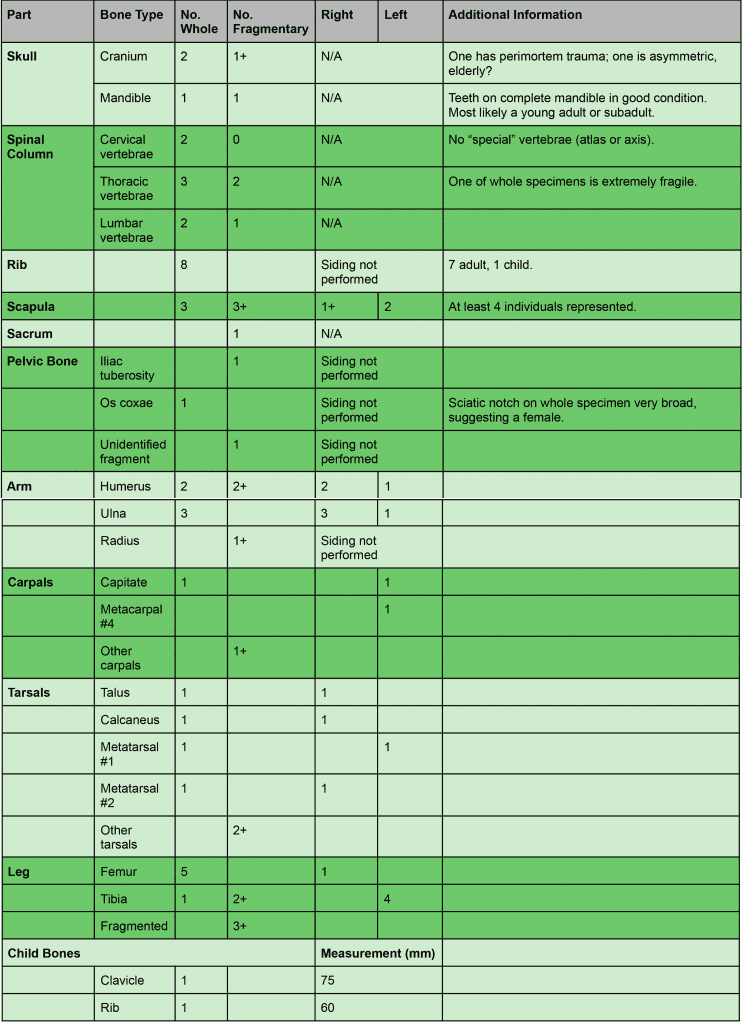
It’s extremely rewarding to be involved in project work diving, especially when we can learn from the remains found and educate the public via the museum along the way. After we surfaced with the bones, we had to transport them to a safe place. A large tub was filled with water from the cave, so the bones could be stored in as close to the same environment as possible. This was then taken down to the nearby Wookey buildings and stored in a cool dark office, much to the amusement of the cave staff! Whilst we, the divers, entertained ourselves searching out the bones, Christopher Binding contacted Marta Kobylinska (the official osteologist) and arranged a meeting and work session so that she could identify exactly what we had found. The dead do tell tales.
Following Marta’s archaeological identification, the bone collection was put on display in the revamped Wookey Hole Cave Museum on May 17, 2021.
Dive Deeper:
Trailer for documentary film ‘Wookey’ by Gavin Newman
Wild Wookey—Adventure Caving at Wookey Hole
InDepth: Meet the British Underground
From GUE’s membership magazine QUEST: “British Cave Diving: Wookey Hole and The Cave Diving Group” by Duncan Price

Michael Thomas’s diving career is now in its 33rd consecutive year, from starting out as an open water diver then a trainee cave diver to becoming the Training Officer of the British Cave Diving Group Somerset Section. He is also a Full Cave Instructor, Sidemount and Tech Instructor with TDI, active mod 3 CCR cave diver, and on the British cave rescue call out list as a diver. He is heavily involved in U.K. diving projects and training, plus overseas diving and caving. Diving is life or is life diving?























